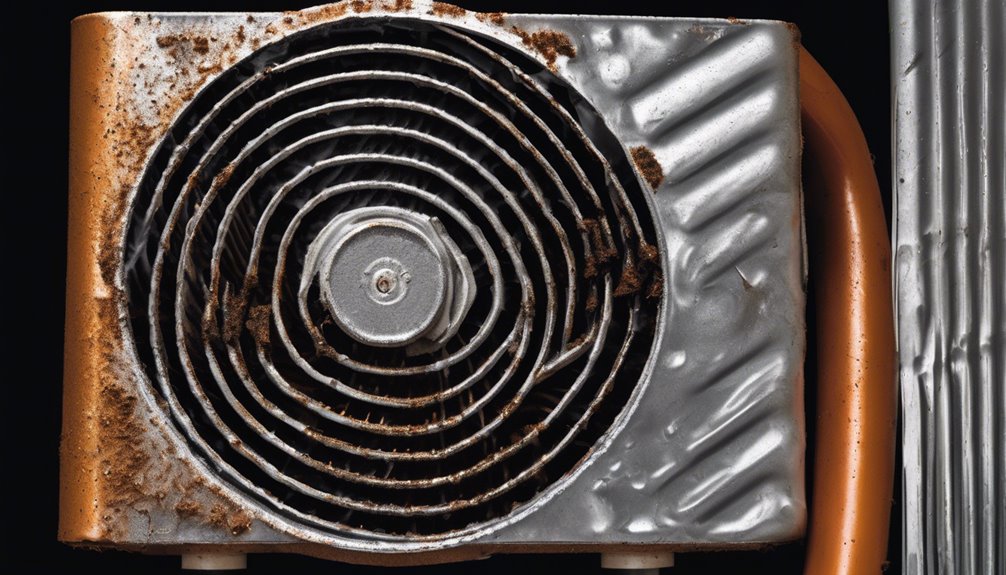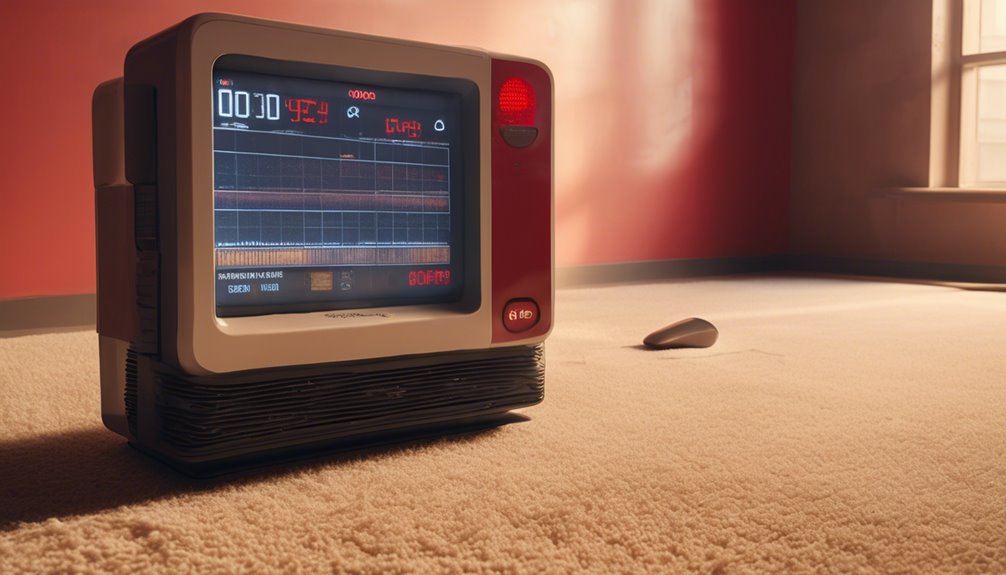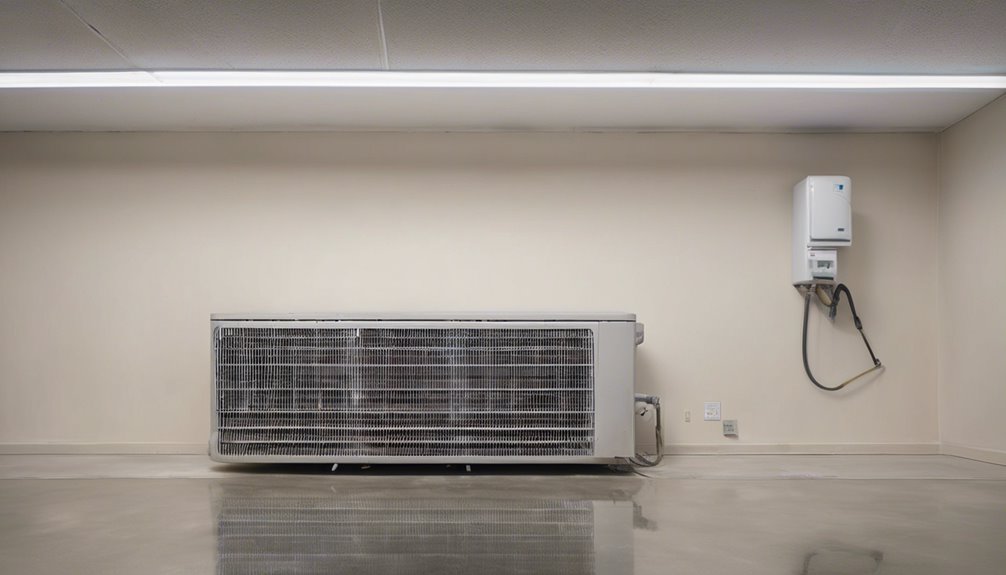To replace an AC fuse at home, start by preparing your workspace with necessary tools and safety gear. Identify the fuse location in your main electrical panel, shut off the power supply, and remove the fuse cover. Inspect the fuses to find the blown one, then install a new one with the same ampere rating. Replace the fuse cover, restore the power supply, and test the AC unit to ensure it's working properly. If you're unsure or want more guidance, continue to ensure a safe and successful replacement.
Key Takeaways
- Ensure a safe working environment by turning off the main power supply, wearing protective gear, and verifying the circuit is de-energized.
- Identify the correct fuse to replace by checking labels or markings on the electrical panel, and purchase a replacement with the same amperage rating.
- Remove the fuse cover, inspect the old fuse for damage, and securely install the new one, handling it by the plastic body to prevent damage.
- Verify the new fuse is securely seated, terminals are clean, and connections are tightened to the recommended torque specification.
- Restore power, check the AC unit's power indicator, and test the air circulation, temperature, and thermostat to ensure proper function.
Prepare for the Replacement
Gather the necessary tools and materials before starting the replacement process.
Prepare thoroughly by collecting essential tools and materials before initiating the fuse replacement procedure.
You'll need a tool checklist that includes a fuse puller, needle-nose pliers, and a replacement fuse of the same amperage rating.
Make sure you have a well-lit workspace and a non-conductive surface to work on.
Take safety precautions seriously – turn off the main power supply to the circuit and verify it's de-energized using a voltage tester.
Wear protective gear like gloves and safety glasses to prevent electrical shock.
Ensure the area is clear of any flammable materials and keep a fire extinguisher nearby.
With your tools and materials ready, you're set to begin the replacement process.
Identify the Fuse Location
You'll typically find the AC fuse located in the main electrical panel or breaker box, usually mounted on a wall or in a closet.
This is where you'll find different fuse types, such as cartridge fuses or plug fuses, each serving a specific purpose in maintaining electrical safety.
Take a closer look at the panel to identify the fuse you need to replace. You might see labels or markings indicating which fuse corresponds to which circuit.
Make sure to exercise caution when working with electrical components, as they can be hazardous if not handled properly. Always prioritize electrical safety to avoid accidents or injuries.
Shut Off the Power Supply
You'll need to shut off the power supply to the circuit before replacing the AC fuse.
To do this, find the main breaker or switch that controls the power to the circuit and flip it to the "off" position.
Next, use a voltage tester to ensure there's no voltage present at the fuse location.
Find Main Breaker
Before starting the replacement process, locate the main breaker that supplies power to the air conditioning unit. This breaker is usually found in the main breaker panel, which is typically located in a basement, garage, or outdoors. Make sure you identify the correct breaker to avoid electrical shocks or other safety hazards.
| Main Breaker Location | Common Features | Electrical Safety |
|---|---|---|
| Basement | Near the electrical meter | Ensure the area is well-lit |
| Garage | On a wall or in a corner | Keep children away |
| Outdoors | In a weather-resistant enclosure | Avoid touching metal parts |
| Hallway | Near the electrical panel | Switch off the main breaker |
| Laundry room | Behind a door or panel | Verify the power is off |
Remember to turn off the main breaker to ensure your safety while replacing the AC fuse.
Check Voltage Readings
Now that you've located the main breaker, shut it off to ensure the power supply to the air conditioning unit is completely cut off.
This is crucial for electrical safety, as you don't want any accidental power surges while you're working on the fuse.
Next, use a voltage meter to check the voltage readings at the main breaker and the AC unit.
This will confirm that the power is indeed off.
Here's what you should do:
- Set your voltage meter to the correct voltage range.
- Touch the meter leads to the main breaker terminals.
- Take note of the reading, which should be zero or very close to zero.
- Repeat the process at the AC unit terminals to ensure there's no residual power.
Remove the Fuse Cover
The fuse cover protects the delicate electrical components inside the fuse box from dust and debris. You'll need to remove it to access the fuses. Take a screwdriver and remove the screws that hold the cover in place. Gently pull the cover off, taking care not to touch any of the electrical components.
| Step | Action | Tool Needed |
|---|---|---|
| 1 | Remove screws | Screwdriver |
| 2 | Pull cover off | – |
| 3 | Inspect cover | – |
| 4 | Set cover aside | – |
During fuse removal, inspect the cover for any signs of damage or wear. If you notice any damage, consider replacing the cover along with the fuse. Now that the cover is removed, you can proceed with the next step in the replacement process.
Identify the Blown Fuse
You'll need to identify the blown fuse to replace it correctly.
Check the fuse box for the affected circuit, looking for burn marks or a broken metal element. Make sure to check the fuse rating to ensure you get a replacement with the same amperage.
Check the Fuse Box
Locate the fuse box, usually found in a basement or utility room, and open it to expose the array of fuses.
You'll see a series of switches or fuses with labels indicating which circuit they control. To identify the blown fuse, look for the one that's tripped or has a broken filament.
Check the fuse labels to ensure you're working on the correct circuit. Remember, electrical safety is key, so make sure you're comfortable with the process before proceeding.
- Check the fuse labels to identify the blown fuse.
- Verify the tripped fuse corresponds to the affected circuit.
- Ensure you have a replacement fuse with the same amperage rating.
- Take note of the fuse's location for future reference.
Look for Burn Marks
How can you be certain you've found the blown fuse?
During fuse inspection, look for burn marks, discoloration, or a broken fuse element. These signs indicate that the fuse has blown and needs replacement.
Check the fuse box carefully, as the blown fuse mightn't be immediately apparent. Ensure you exercise electrical safety by turning off the main power supply before starting the inspection. Don't touch any electrical components with your bare hands, and avoid using metal objects to test for voltage.
A thorough inspection will help you identify the blown fuse, allowing you to replace it safely and efficiently.
Check Fuse Rating
The fuse rating is crucial in identifying the blown fuse, as it helps you determine the correct replacement.
You don't want to replace a fuse with one that has a higher or lower amperage rating, as it can compromise fuse safety. Check the blown fuse for its rating, usually indicated by a number or color code.
When checking the fuse rating, consider the following:
- Ampere rating: Ensure the replacement fuse has the same ampere rating as the blown one.
- Voltage rating: Verify the replacement fuse's voltage rating matches the blown fuse's.
- Fuse types: Identify the type of fuse (e.g., slow-blow or fast-acting) to ensure a compatible replacement.
- Certifications: Look for certifications like UL (Underwriters Laboratories) or CE (Conformité Européene) to ensure the replacement fuse meets safety standards.
Purchase a Replacement Fuse
You'll need to find a replacement fuse that matches the exact specifications of the one you're replacing.
There are various fuse types, including slow-blow, fast-acting, and high-current fuses, so make sure you get the right one.
You can find replacement fuses at online retailers like Amazon or Home Depot's website.
Check the product description to ensure the fuse you're buying has the same amperage rating, voltage rating, and physical dimensions as the old one.
If you're unsure, consult the manufacturer's instructions or contact their customer support.
Once you've found the correct replacement fuse, add it to your cart and complete the purchase.
Install the New Fuse
You're now ready to install the new fuse.
Follow the manufacturer's instructions for the correct fuse installation steps, ensuring you handle the fuse by the plastic body to prevent damage.
Make sure to secure the fuse connection tightly to prevent it from coming loose over time.
Fuse Installation Steps
One new fuse is all you need to get your AC up and running again.
Make sure you've purchased the correct fuse type, as specified in your AC's manual or on the manufacturer's website.
Now, follow these installation steps:
- Turn off the power: Switch off the main electrical supply to your AC unit to ensure your safety while working on the fuse.
- Remove the fuse cover: Take out the fuse cover or panel to access the fuse holder.
- Pull out the old fuse: Gently pull out the blown fuse from its holder.
- Insert the new fuse: Place the new fuse into the holder, making sure it's securely seated.
Remember to prioritize DIY safety when working with electrical components.
Secure Fuse Connection
The new fuse is now in place, but it's crucial to ensure a secure connection to prevent future issues.
You'll want to double-check that the fuse is seated properly and all electrical connections are snug. Loose connections can lead to overheating, arcing, or even fires, compromising fuse safety.
Verify that the terminals are clean and free of corrosion, and that the fuse is securely fastened to the fuse box. Make sure all electrical connections are tightened to the recommended torque specification.
Replace the Fuse Cover
Replacing the fuse cover is a crucial step in the process, as it protects the internal components of your AC unit from dust, moisture, and other environmental factors that could cause damage.
You've already secured the fuse connection, now it's time to put the cover back on. Make sure you handle it carefully to avoid any electrical shock or further damage.
To ensure proper fuse maintenance and electrical safety, follow these steps:
- Align the cover with the fuse box and gently push it back into place.
- Ensure the cover is securely fastened with screws or clips.
- Double-check that all internal components are completely covered.
- Verify that the cover is tightly sealed to prevent any air leaks.
Restore the Power Supply
You've successfully replaced the fuse cover, and now it's time to restore the power supply to your AC unit. This is a crucial step in getting your AC up and running again. To ensure electrical safety, make sure you've followed all the necessary precautions before restoring power.
| Step | Action |
|---|---|
| 1 | Turn off the main power switch or circuit breaker |
| 2 | Verify that the AC unit is not live using a non-contact voltage tester |
| 3 | Flip the switch or reset the circuit breaker to restore power |
| 4 | Check the AC unit's power indicator to ensure it's receiving power |
Test the AC Unit
With the power supply restored, your AC unit should now be humming back to life.
It's crucial to test it to ensure everything is working smoothly. Check for any unusual AC smells, which could indicate a more serious issue.
Turn on the AC and observe the air circulation. You should feel a gentle flow of cool air coming from the vents.
- The AC is blowing cold air.
- The air circulation is consistent and not weak.
- There are no strange noises or vibrations.
- The thermostat is working correctly, and the temperature is set to your liking.
If everything checks out, you've successfully replaced the AC fuse and restored your unit to its former glory!
Frequently Asked Questions
Can I Replace an AC Fuse With a Higher Amp Rating?
You're wondering if you can swap an AC fuse with a higher amp rating. While it might seem like a harmless upgrade, it's crucial to understand that doing so can create serious fuse upgrade risks. Always stick to amp rating standards to ensure safety.
Will a Blown Fuse Affect My Ac's Thermostat?
You're wondering if a blown fuse will affect your AC's thermostat. It's unlikely, but a faulty wiring design could cause a thermostat malfunction. Check your wiring first, then investigate the thermostat if issues persist.
Can I Use a Fuse From a Different AC Model?
You shouldn't assume a fuse from a different AC model will work; model differences can affect fuse compatibility, and using the wrong one can cause damage or even a fire, so it's crucial to find the exact replacement fuse.
How Often Should I Inspect My AC Fuses?
You should inspect your fuses regularly, ideally during seasonal checks, to ensure they're functioning properly. As part of your fuse maintenance, check for signs of wear, corrosion, or damage every 3-6 months to prevent unexpected AC breakdowns.
Do I Need to Clean the Fuse Box Before Replacement?
Before replacing the fuse, you'll want to clean the fuse box to ensure a smooth process. Remove any dusty connectors and wipe away corrosion buildup to prevent electrical shocks or faulty connections.
Conclusion
You've successfully replaced the AC fuse at home. Now, turn on the power supply and test the AC unit to ensure it's working properly. Check for any signs of overheating, strange smells, or unusual noises. If everything seems fine, you're good to go! Remember to handle electrical components with care and consider seeking professional help if you're unsure about any step in the process.



